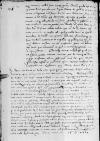Accepi hic ⌊⌋ iis diebus a te. ⌊⌋ XVIII Februarii dedisti, redditae mihi sunt paper damaged⌈[nt]nt paper damaged⌉ violatae et apertae. Velim scire, cui eas deferendas commiseris. ⌊⌋ illustrissimo ⌊comiti paper damaged⌈[ti]ti paper damaged⌉ de Nassau⌋. ⌊⌋ misi ⌊Georgio Hegel⌋, ut non meis impensis ex ⌊Cracovia⌋, sed per occuren paper damaged⌈[n]n paper damaged⌉tem nuntium eas mittat ⌊Antverpiam⌋. Ex ⌊Antverpia⌋ vero impendi iussi, ut perveniant paper damaged⌈[t]t paper damaged⌉ in
⌊Bredam⌋ referaturque mihi responsum. Pro prioribus solvi VIII flor(enos) etc.
Mitto et ⌊⌋ earundem tibi exemplum, quod serenissimae ⌊reginali maiestati⌋ interpretaberis, cui etiam et de pictulis scripsi. Tuum erit me ⌊eius maiestati⌋ commendare quam diligentissime, et de omnibus mihi ⌊⌋ etc.
Gemma illa cum sculptis meis armis et chalibs sculptus nondum a me visus est. Da operam, ut cum hoc meo nuntio mittantur. Domino ⌊Georgio⌋ scripsi, ut det pecuniam etc.[1]
Mi carissime Fabiane.
Velim hanc a me paternam et Christianam admonitionem, qua tibi optime volo, non gravate admitteres, id paper damaged⌈[d]d paper damaged⌉eo, ut vitam in melius commutares, maxime autem ab omni immunditia et a scortis tibi temperares, ne accipiens membra ⌊Christi⌋, ut ⌊Paulus⌋ inquit,
cf. Vulg. Cor1 6, 15-19 corpora vestra membra Christi sunt, tollens ergo membra Christi faciam membra meretricis absit. An nescitis quoniam qui adheret meretrici unum corpus efficitur? – – membra vestra templum est Spiritus Sancti ⌊ea membra scorti facias, templumque Dei, quod tu es, prophanescf. Vulg. Cor1 6, 15-19 corpora vestra membra Christi sunt, tollens ergo membra Christi faciam membra meretricis absit. An nescitis quoniam qui adheret meretrici unum corpus efficitur? – – membra vestra templum est Spiritus Sancti ⌋. Quod si hanc meam, immo ipsius ⌊divi Pauli⌋ cohortationem secutus fueris sordesque eas, quae et corpori, et anime obsunt, quin etiam famam favoremque apud homines minuunt, reliqueris, facile ea, ad que aspiras, atque etiam longe maiora assequi poteris.
cf. WALTER No. 24a Nil volenti difficile; Nowa księga przysłów i wyrażeń przysłowiowych polskich 1, p. 244-245 S. V. Chętny 4 Nic trudnego dla chętnego; Ter. Hau. 675 Nil tam difficilest, quin quaerendo investigari possiet; Cic. Fam. 3. 9. 1 Nihil est enim, quod studio et benevolentia vel amore potius effici non possit ⌊Nihil volenti difficilecf. WALTER No. 24a Nil volenti difficile; Nowa księga przysłów i wyrażeń przysłowiowych polskich 1, p. 244-245 S. V. Chętny 4 Nic trudnego dla chętnego; Ter. Hau. 675 Nil tam difficilest, quin quaerendo investigari possiet; Cic. Fam. 3. 9. 1 Nihil est enim, quod studio et benevolentia vel amore potius effici non possit ⌋. Quod si forsan tibi in primis continentia gravis videbitur (quandoquidem levis non est), subsidium pete a Deo, qui casta et
pura petentibus ilico praesto est, opem suam, modo vero rectoque corde petatur, habunde largitur omnibus. Ille te per suam gratiam ad se convertat et hanc meam ad te commonitionem frugiferam faciat.
Bene vale.

 BCz, 244, p. 206
BCz, 244, p. 206